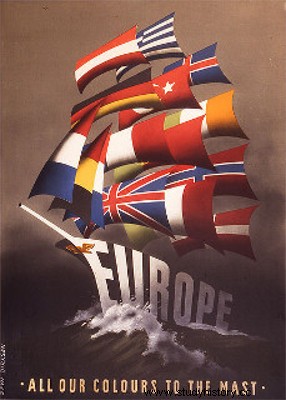
By Me. Tales Pinto
After the end of World War II, the USA and the winning allied countries, those located in Western Europe, needed to rebuild the European economy devastated by the long years of conflict to which they were subjected. It was still necessary for these countries to contain the threat of expanding Soviet influence. In this context of economic reconstruction and the Cold War, the Marshall Plan was launched in 1947. .
The Marshall Plan (officially European Recovery Program , or European Recovery Program ) was named after its founder, General George Catlett Marshall , former Chief of Staff of the US Army and, at the time the plan was launched, Secretary of State to US President Henry Truman. The Marshal Plan was an ambitious project of loans and financial donations made by the US and its capitalists to European countries devastated by World War II.
The Soviet Union had emerged prestigious from the world conflict as a result of the victory over the Nazis, the millions of dead that fell in combat and the attacks of German troops. There was also the fact that during the 1930s, when much of the economy of the western world was in deep crisis, beginning in 1929, the Soviet planned economy reached very high levels of growth.
Furthermore, in countries such as Italy and France, the Communist Parties aligned with Moscow demonstrated considerable strength. In Germany destroyed and divided into two zones of influence, quick action was necessary to contain the Soviets, who kept their armies still mobilized.
The solution conceived with the Marshall Plan was to carry out a campaign against communism from the economic reconstruction of countries, restructuring their industries and rapidly increasing the consumption level of their populations.
Between 1948, the year the Marshall Plan came into force, and 1951, the year it ended, around 18 billion dollars were delivered to European countries adhering to the plan through donations and loans. To carry out the plan, the US created the Administration of Economic Cooperation (Economic Cooperation Administration , ECA.)
The offer of economic aid was also offered to the USSR, but was refused as Stalin intended to restructure the economies of his zone of influence without the support of Western capitalism. Faced with this, European countries created, in 1948, the European Organization of Economic Organization (OEEC), the embryo of what would become the Organization for Economic Cooperation and Development (OECD). From these initiatives would also emerge the European Common Market and later the European Union.
With the credits from the Marshal Plan, it was possible for all Western European countries (except Franco's Spain and Finland, a neighbor of the USSR) to buy food, agricultural products, industrialized products and fuels, mostly from the US.
The Marshall Plan also served for the constitution of what would come to be known as the Welfare State , in which part of the services needed by the population (health, education, unemployment insurance, etc.) were offered by the State. In this way, Western capitalists faced Soviet influence with the improvement of the population's economic conditions.
On the other hand, the Marshall Plan represented one of the first efforts towards the internationalization of capital and capitalists in the world. Through an economic and social plan, national borders were overcome by capitalism, which a few years earlier had been the cause of a military conflict that resulted in the death of more than 50 million people.
